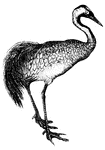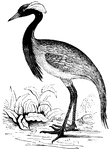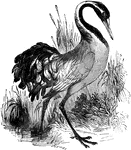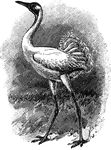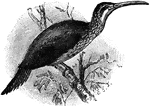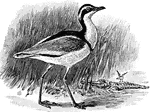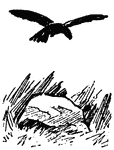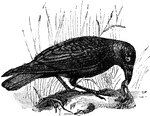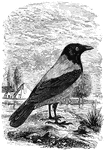218 illustrations of birds including: calyptomena, canary, capercaille, caracara, cariama, carrion-crow, cassican, cassowary, cat-bird, ceyx, chiff chaff, chaffinch, chat, chick, chickadee, chicken, chough, chuck-will's-widow, cock, cockatoo, columba, condor, athene conneviens, coot, corella, cormorant, cotinga, courser, cow-bird, crane, creeper, criniger, crossbill, crow, crypturus, cuckoo, curassow, and curlew

Cow-blackbird
A migratory bird, the cow-blackbird is notable among birds, for it does not build a nest.
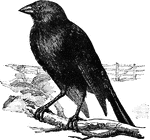
Cowbird
Frequenttly deposites its eggs in the nests of other birds, leaving them to hatch by their foster parents.
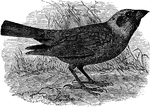
Common Cowbird
"Molothrus ater. Common Cowbird. Cuckold. male Adult: Lustrous green-black, with steel-blue, purple,…

Crane
Cranes are large, long-legged and long-necked birds of the order Gruiformes, and family Gruidae. Unlike…

Balearic Crane
The balearic crane (also known as the crowned crane) stands about four feet high, and is easily domesticable.

Common European crane
The common crane of Europe is mostly of a blueish-ash color, feeding on worms, insects, reptiles, mollusca,…
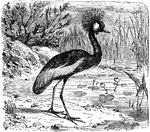
Crested Crane
"The Crested Crane has the top of its head adorned with a tuft of feathers, which it has the power of…
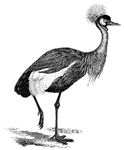
Crowned Crane
"Balearica pavonina, the "Crowned" Crane of the Northern Ethiopian Region, is greenish-black above and…

Demoiselle Crane
"It is gifted with great powers of mimicry. Its movements have an air of affectation and mannerism,…

Numidian Crane
A large bird so called for its gracefulness and symmetry in form. Feeds mostly on fish.

Numidian Crane
Averaging about three feet in length, the numidian crane makes its home in Africa, though it has been…
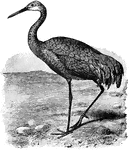
Sandhill Crane
Common in Florida, the sandhill crane (Grus canadensis) is a large bird with a wingspan of up to seven…
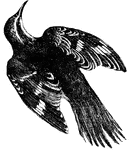
Creeper
The Creepers are small climbing birds which live and build their nests in the holes they bore in the…

Creeper
The Creepers are small climbing birds which live and build their nests in the holes they bore in the…

Creeper
The Creepers are small climbing birds which live and build their nests in the holes they bore in the…

Black and White Creeper
"Black and White Creeper or Mniotilta varia. Black; edges of feathers of upper parts, coronal, superciliary,…
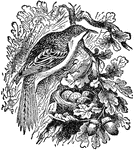
Brown Creeper
The Brown Creeper (Mohoua novaeseelandiae), also known by its Māori name, Pipipi, is a small…
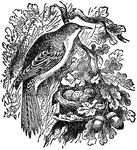
Common Creeper
"Creepers are a family of birds which strongly resemble the woodpeckers in their habit of creeping on…
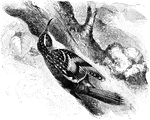
Common Brown Creeper
"Common Brown Creeper. Upper parts dark brown, changing to rusty-brown on the rump, everywhere streaked…
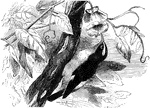
Honey Creeper
"Certhiola flaveola. Honey Creeper. Dark brown above; long superciliary line and under parts dull white;…
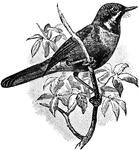
Pectoral Honey Creeper
A bird with a very acute curved bill finely serrate along a part of the cutting edges, and the toungebifid,…

Tree Creeper
"Certhia familiaris, the Tree Creeper, the coloration of both sexes is brown, black, rufous, buff, grey,…
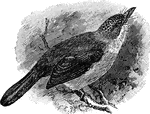
Criniger
A genus of birds. So called from the hair-like filaments with which some of the feathers end.
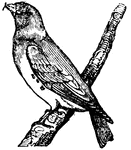
Crossbill
Known for their distinct crossed bill, these birds eat seed from mature conifer cones. Their unique…
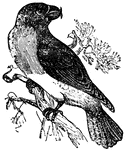
Crossbill
Known for their distinct crossed bill, these birds eat seed from mature conifer cones. Their unique…

Crossbill
Known for their distinct crossed bill, these birds eat seed from mature conifer cones. Their unique…
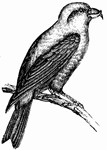
Crossbill
Known for their distinct crossed bill, these birds eat seed from mature conifer cones. Their unique…
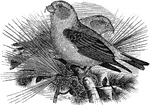
American Red Crossbill
"Loxai curvirostra. American Red Crossbill. Red; wings and tail blackish, without white markings. Middle…

Red Crossbill
A bird in which each mandible of the bill is laterally deflected, so the tips of the two mandibles cross…

White-winged Crossbill
"Loxia leucoptera. White-winged Crossbill. Rosy-red, sometimes carmined or even crimsoned, obscured…
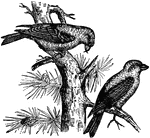
Crossbills
"They are sometimes found near orchards, feeding on the kernels of apples, which their bills readily…
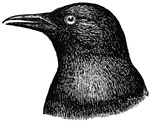
Crow
The true crows are large passerine birds that comprise the genus Corvus in the family Corvidae. Ranging…

Blue Crow
"Gymnocitta cyanocephala. Blue Crow. Male: Dull blue, very variable in intensity, nearly uniform, but…
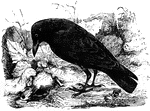
Carrion-Crow of Europe
The carrion-crow of Europe has been known to feed on decaying flesh, as well as young birds, shellfish,…
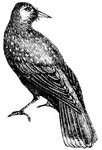
Nut-cracker Crow
The nutcracker has a straight bill for penetrating under the bark of trees in search of insects, (Figuier,…

Rusty Crow-Blackbird
Resembling the crow-blackbird, the rusty crow-blackbird inhabits much the same region, but is less in…
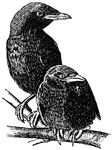
Crows
The true crows are large passerine birds that comprise the genus Corvus in the family Corvidae. Ranging…
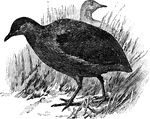
Crypturus
The tinamous as a genus of birds: so called from the extreme shortness of the tail, the rectrices or…

Cuckoo
Cuckoos have elegant shapes; beaks almost as long as the head, compressed, and slightly curved; the…




